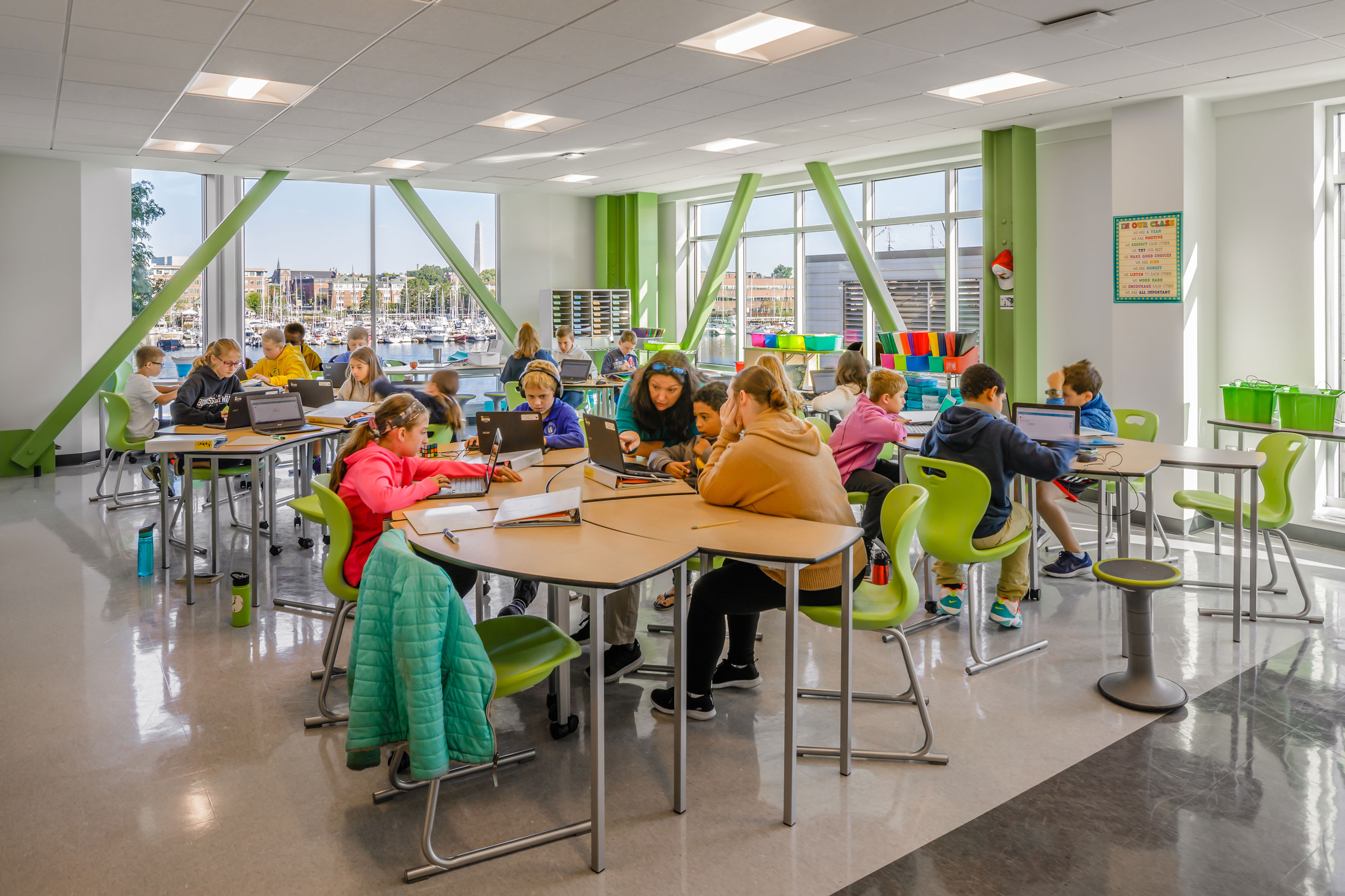The Eliot Innovation School was a model adaptive reuse project, transforming a former concrete office building into an inspiring educational space for all its students. Last week, Principal Regan Shields Ives published an article titled, "School Conversion Proves Concept in the North End" in Banker & Tradesman detailing the transformation of the Eliot school and the practical and playful design the firm employed. Read the article on Banker & Tradesman here or below!
School Conversion Proves Concept in the North End
1960s-Era Offices Transformed into Innovation Classrooms
Boston is experiencing a significant decline in demand for office buildings, a trend supported by high vacancy rates and declining commercial property values.
The city offers significant incentives for the adaptive reuse of downtown office buildings into housing, including a pilot program providing up to a 75 percent property tax abatement for up to 29 years, fast-tracked permitting, and as-of-right zoning. The strategy seems to be working. Boston’s program has received applications to convert more than 600,000 square feet of office space.
Adaptive reuse is not a new concept, however, and long before financial incentives made it more attractive, vacant commercial buildings had been successfully repurposed by owners who realized their potential and had the funding to transform them into something else. This is the story of one such endeavor.
Innovation a Theme at Eliot School
Established in 1713 as the North Writing School and later becoming the John Eliot School, the Eliot withstood more than 300 years of change. By 2007, the pre-K-8 school that had educated such famous Bostonians as Samuel Adams and Paul Revere was being considered for closure due to low performance.
The catalyst for securing a bright future for Boston’s oldest continuously run school was Traci Walker-Griffith, hired that year by Boston Public Schools as the Elliot’s new executive director.
Within five years, the Eliot had been reclassified as an “innovation school,” with a flexible structure that allowed new approaches to curriculum, staffing, teaching methods, and assessment. As enrollment surged, so did the need for additional facilities.
A search based on location, square footage and adaptability criteria revealed 585 Commercial St. to be a prime candidate.
Before committing to the site, Finegold Alexander Architects, the architecture firm already collaborating with BPS, was engaged to conduct a “test fit.” The program was determined by how many classrooms and support areas could be accommodated within the building’s spatial constraints.
Its suitability thus confirmed, the city of Boston purchased the building in 2013 for $12.5 million and transferred ownership to BPS five years later.
Nondescript Building Given New Identity
Constructed in 1962, 585 Commercial St. was a one-way concrete slab structure. It originally featured a brick infill facade, which was later removed and replaced with EIFS.
The value was in the structure itself: solid, full of embodied carbon and eminently workable. The logical approach was to retain the structure and core and demolish almost everything else.
With the program in place, the challenge was how to give a nondescript office building the identity of a school and enable it to perform as such. Inspiration was derived from Eliot’s education mission, which emphasizes fully-engaged teaching and learning in a conducive physical environment.

The design team faced not only the city’s rigorous design review process but also the demands of bringing a 60-year-old building into compliance with modern codes, seismic standards and 21st century technology.
The 18 general classrooms, three specialty spaces, a robotics and technology lab, media center, art studio and a multi-purpose cafeteria space encircle the central service core. Located adjacent to the Boston Harborwalk, the first-floor spaces and playground remain publicly accessible after hours in compliance with Chapter 91, preserving community use of the waterfront.
A Playful, Practical Design
The completed design blends playfulness and practicality and, as with any project, key decisions shaped outcomes.
Deliberately departing from the North End’s red brick vernacular, the design adopts a unique identity through an earth-air-water color scheme and a facade punctuated by eight projecting bays, each a “learning nook” that fosters collaboration.
Prioritizing sustainability and resiliency, the building features a new reflective roof, high R-Value insulation, and glazing that maximizes natural light. MEP improvements include an electrical service on the second floor for climate resilience, a fire protection system, high-efficiency rooftop units and 98 percent efficient boilers.
Seismic bracing was required throughout, with the structural braces left exposed as a visual teaching tool.
Opened in September 2019, the Eliot’s Upper School demonstrates how due diligence in the initial building search, confirmation of adaptability to a new use and a shared vision can turn a once-unremarkable office building into a vital community anchor.
Eliot’s executive director described the transformation succinctly: “It’s a game changer,” Walker-Griffith said. “We’re doing things we could not have imagined before having this building.”

